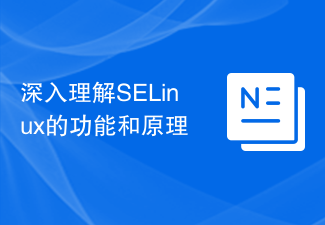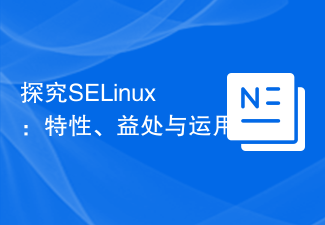Found a total of 10000 related content

PHP password security enhancement and storage recommendations
Article Introduction:PHP password security enhancement and storage recommendations With the continuous development of the Internet, the importance of password security has attracted more and more attention. Correctly handling and storing user passwords is a crucial step when programming in PHP. This article will introduce some PHP password security strengthening and storage recommendations, and provide code examples. Using a Password Hashing Algorithm A password hashing algorithm is a method of converting a user's password into an irreversible string of characters. Common password hashing algorithms include MD5, SHA1, bcrypt, etc. These algorithms can convert a password into a
2023-08-07
comment 0
1052

A Deep Dive into SELinux: A Comprehensive Analysis
Article Introduction:What is SELinux? This article explains in detail that SELinux (Security-EnhancedLinux) is a security-enhanced Linux system security extension module designed to improve the security of the Linux operating system. By implementing a Mandatory Access Control (MAC) mechanism, SELinux can limit program access and protect the system from malware and attackers. In this article, we will explain in detail how SELinux works and provide specific code examples to
2024-02-26
comment 0
1218

What is SELinux
Article Introduction:SELinux refers to security-enhanced Linux. It is a security subsystem of Linux. It is designed to enhance the security of the traditional Linux operating system and solve various permission problems in the discretionary access control (DAC) system of the traditional Linux system (such as excessive root permissions). higher). SELinux uses a mandatory access control (MAC) system, which controls whether a process has access rights to files or directories on a specific file system.
2023-02-08
comment 0
3973

In-depth understanding of the functions and principles of SELinux
Article Introduction:SELinux is a Mandatory Access Control (MAC) security mechanism used to protect Linux operating systems and applications from malicious attacks and unauthorized access. This article will deeply explore the functions and principles of SELinux, and provide specific code examples to help readers better understand and apply this security tool. 1. The role of SELinux SELinux is a security mechanism implemented at the kernel level. Its purpose is to strengthen the security of the Linux system and provide more fine-grained access control. Compared to passing
2024-02-24
comment 0
1031

Study the three policy types of SELinux
Article Introduction:SELinux (Security-EnhancedLinux) is a security subsystem in the Linux system. It provides an access control security mechanism and restricts the behavior of programs and users through mandatory access control (MAC) to improve system security. The core of SELinux is a policy-based mechanism, which can control different access permissions through different types of policies. In SELinux, there are three main policy types, including: role-based access control (RBAC), basic
2024-02-26
comment 0
1020

What is SELinux used for?
Article Introduction:The main function of SELinux is to minimize the resources accessible to the service process in the system (the principle of least privilege), and to limit malicious code activities in the Linux system to the maximum extent possible. SELinux is a security enhancement function module deployed in Linux systems. It provides improved security for Linux systems by using MAC (mandatory access control) for process and file resources.
2023-02-10
comment 0
3618

In-depth analysis: the concept and role of SELinux
Article Introduction:SELinux is a security-enhanced Linux system, its full name is Security-EnhancedLinux, which aims to improve the security of the Linux operating system. SELinux is designed to provide more granular access control on top of traditional Linux permission management to protect the security of system resources and data. This article will delve into the definition and functions of SELinux and provide specific code examples to help readers better understand and use SELinux. 1. S
2024-02-24
comment 0
1043

What is selinux in centos
Article Introduction:In centos, selinux is the abbreviation of "Security Enhanced Linux", which is a security-enhanced Linux, a Linux kernel module, and a security subsystem of Linux; the main function of SELinux is to minimize the accessibility of service processes in the system. resource.
2022-04-14
comment 0
4456

Study the three policy types of SELinux
Article Introduction:SELinux is a security-enhanced Linux operating system security module. Its core is to improve system security through mandatory access control. In SELinux, policy types are an important part of defining security policies. According to different needs and scenarios, SELinux provides three different policy types, namely MLS (Multi-LevelSecurity), TE (TypeEnforcement), RBAC (Role- BasedAcc
2024-02-26
comment 0
929

An in-depth discussion of the three working modes of SELinux
Article Introduction:Detailed explanation of the three working modes of SELinux SELinux is a mandatory access control (MAC) technology designed to enhance the security of Linux systems. It uses tags to mark resources in the system (such as files, processes, and ports) and defines policies to control process access to these resources. In SELinux, there are three main working modes: forced mode, elastic mode and harmless mode. This article will introduce these three working modes in detail and provide specific code examples. Enforcing mode
2024-02-26
comment 0
708

applescript simulates mouse movement
Article Introduction:This article focuses on automating mouse movement using AppleScript, a powerful scripting environment for macOS. The main topic discussed is the set mouse position command, its syntax, limitations, and potential security restrictions in certain macOS
2024-08-15
comment 0
1014

In-depth exploration of the three policy classifications of SELinux
Article Introduction:SELinux is a mandatory access control security technology used to enhance the security of Linux operating systems. In SELinux, policies are divided into three main categories: TargetedPolicy, Multiple Policies (MLS/MCSPolicy), and CustomPolicy. These three policy classifications play an important role in the security mechanism of SELinux. This article will introduce these three policies in detail with specific code examples.
2024-02-26
comment 0
1039

Understand the different working modes of SELinux
Article Introduction:SELinux is a security-enhanced Linux. Its full name is Security-EnhancedLinux, which is a security module of the Linux kernel. It can provide mandatory access control function, through which the security of the system can be better protected. SELinux can effectively prevent malicious programs from abusing system resources by controlling the permissions of processes to access resources. In SELinux, there are three working modes: Enforcing, Permissiv
2024-02-26
comment 0
863

An in-depth analysis of the three policy types of SELinux
Article Introduction:Detailed explanation of the three policy types of SELinux and code examples SELinux (Security-EnhancedLinux) is a security subsystem that implements mandatory access control on the Linux operating system. It ensures the security of the system by defining mandatory access rules for each operation. In SELinux, there are three main policy types: Enforcing, Permissive, and Disabled. This article will introduce these three in detail
2024-02-26
comment 0
1059

Familiar with the three working modes of SELinux
Article Introduction:SELinux (Security-EnhancedLinux) is a security module that implements Mandatory Access Control (MAC) in Linux systems. It enforces security policies by applying labels to system objects (files, processes, etc.) for more fine-grained access control. SELinux has three working modes: Enforcing, Permissive and Disabled. This article will introduce these three modes in detail and provide specific code examples. 1
2024-02-26
comment 0
1072

What are the security considerations for deploying PHP applications in the cloud?
Article Introduction:The main security considerations for deploying PHP applications in the cloud include: Network security: Use SSL/TLS to encrypt traffic, enable firewalls, and restrict access from external IP addresses. Server configuration: Update patches in a timely manner, disable unnecessary services, and optimize PHP configuration. Code safety: validate input, use validated libraries to handle input, enable error reporting. Database security: Use strong passwords, restrict access, and back up regularly. File system security: restrict access permissions, use chroot to limit access, monitor file system activity.
2024-05-06
comment 0
483

Explore SELinux: Features, Benefits, and Usage
Article Introduction:In order to better understand SELinux, we first need to understand what SELinux is, what its functions are, and its advantages and application areas. This article will lead readers to delve into SELinux and use specific code examples to help readers better understand its operating mechanism and applications. SELinux, the full name of Security-EnhancedLinux, is security-enhanced Linux. It is a highly secure operating system security module. It is used in Linux
2024-02-24
comment 0
767

How to configure powerful container security tools on Linux
Article Introduction:How to configure powerful container security tools on Linux With the widespread application of container technology, container security has become particularly important. Properly configured container security tools can effectively protect applications and data in containers and prevent potential attacks and data leaks. This article will introduce how to configure several powerful container security tools on Linux and provide code examples for reference. SELinux (Security-EnhancedLinux) SELinux is a Linux kernel security enhancement module that can
2023-07-05
comment 0
746

Master the SELinux Policy Categories
Article Introduction:SELinux is a MandatoryAccessControl (MAC)-based security mechanism used to restrict program and user access to system resources. In SELinux, policy types are one of the important concepts used to define and control access rights to objects. This article will introduce the policy types in SELinux and use specific code examples to help readers better understand. Overview of SELinux policy types In SELinux, each object (file, process, etc.) has an associated
2024-02-26
comment 0
577

OK Exchange currency withdrawal rules and precautions
Article Introduction:OK Exchange currency withdrawal rules and precautions: real-name authentication and setting of transaction password are required. There are daily, weekly and monthly currency withdrawal limits and handling fees; precautions include confirming the withdrawal address, selecting the matching network, and checking the handling fees. , pay attention to currency withdrawal restrictions, strengthen account security, and pay attention to network congestion and abnormal currency withdrawals.
2024-09-09
comment 0
571



















